URBANA — Black holes get a bad rap in science fiction. They’re often portrayed as massive monsters of unrelenting hunger, gobbling up spaceships, planets and Matthew McConaughey.
But these depictions aren’t really accurate.
“They’re not going to eat us,” said Liam Nolan, an astronomy graduate student at the University of Illinois Urbana-Champaign. He laughed as he explained that those stories are fun in fiction; but in reality, black holes have a lot to teach us.
At the center of our galaxy, the Milky Way, resides a supermassive black hole called Sagittarius A*. The James Webb Space Telescope has now given astronomers the longest, most detailed look at the black hole yet.
What they found was a light show: flickers and bursts of light coming from around Sagittarius A*. The light from these flares travels 26,000 lightyears — or 152 quadrillion miles — before it reaches the Webb telescope. For context, this means the light the Webb telescope sees today was emitted while the Ice Age was still happening on Earth.
Qiaoya Wu, another U of I graduate student in astronomy, says black holes have a lot to teach us.
“Doing observations on [black holes], we can improve our study of fundamental physics and push our science,” Wu said.
Wu says she has surprised people when she tells them black holes have structure and are not literal holes things can fall into.
Black holes consist of several parts. NASA provides an interactive anatomy breakdown on its website. At the center is the singularity, a theoretical point of infinite density. Whether or not the singularity is an actual physical structure remains unknown.
“They are very unique laboratories that the universe has set up for us to figure out types of physics that we can’t simulate on Earth,” Nolan said.
A team of astrophysicists led by Northwestern University’s Farhad Yusef-Zadeh recently published a peer-reviewed research study in The Astrophysical Journal Letters, sharing their findings on the flares seen using Webb. In a NASA article, Yusef-Zadeh said the team saw “constantly changing, bubbling brightness” in the data.
“And then boom! A big burst of brightness suddenly popped up. Then, it calmed down again. We couldn’t find a pattern in this activity. It appears to be random,” he said.
Yusef-Zadeh said these light flares are coming from Sgr A*’s accretion disk, the glowing disk of gas orbiting the black hole.
A better understanding of black holes could mean a better understanding of galaxies, said David Leake, former director of Staerkel Planetarium at Parkland College and co-founder of the Champaign-Urbana Astronomical Society.
“We’re learning that a lot of these galaxies have black holes in the center of them, and so learning about those will help us try to figure out what’s going on with galaxy formation,” Leake said.
The Webb telescope’s superior observations are partially owed to its location. Since 2022, Webb has been orbiting the sun one million miles from Earth. This location, called the second Lagrange point, allows for Webb to stay near Earth as it orbits. It moves around this point, avoiding Earth’s shadow. This means Webb can be operational at all times.
It’s that perfect spot in space that allows Webb to observe Sgr A* for extensive periods of time. That is exactly what Yusef-Zadeh is hoping for: 24 hours of uninterrupted viewing.
“If we can observe for 24 hours, then we can reduce the noise to see features that we were unable to see before,” Yusef-Zadeh said in the NASA article.
The team is also hoping to see if the light flares repeat themselves or are truly random.
“That’s really kind of the big research push right now,” Leake said. “Let’s get better images, longer timescales.”
Thanks to Webb, such a feat can be possible.

